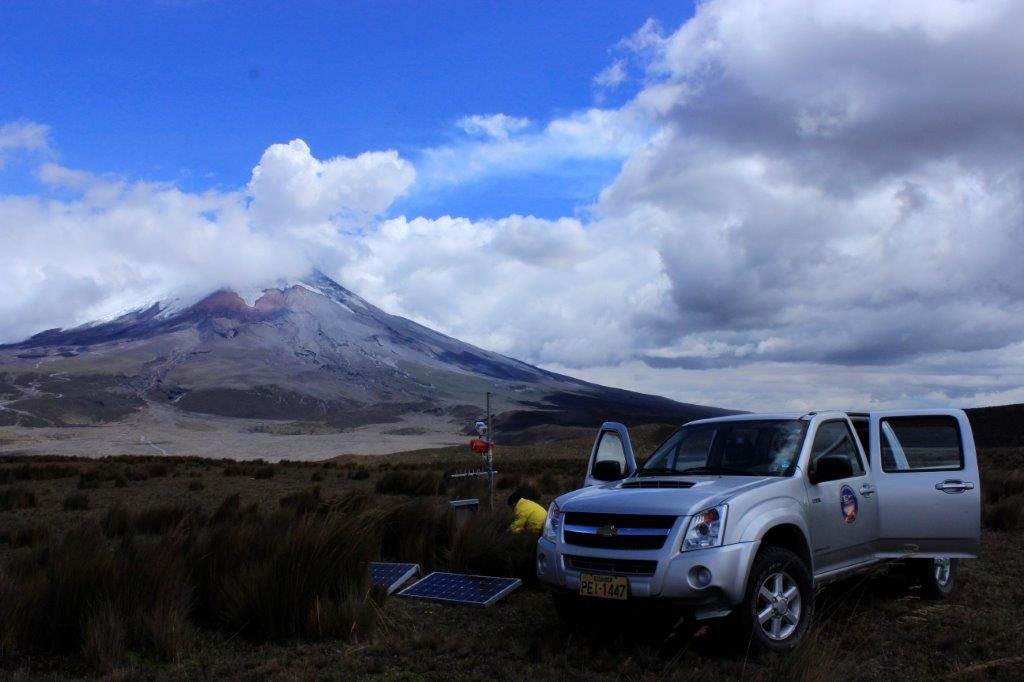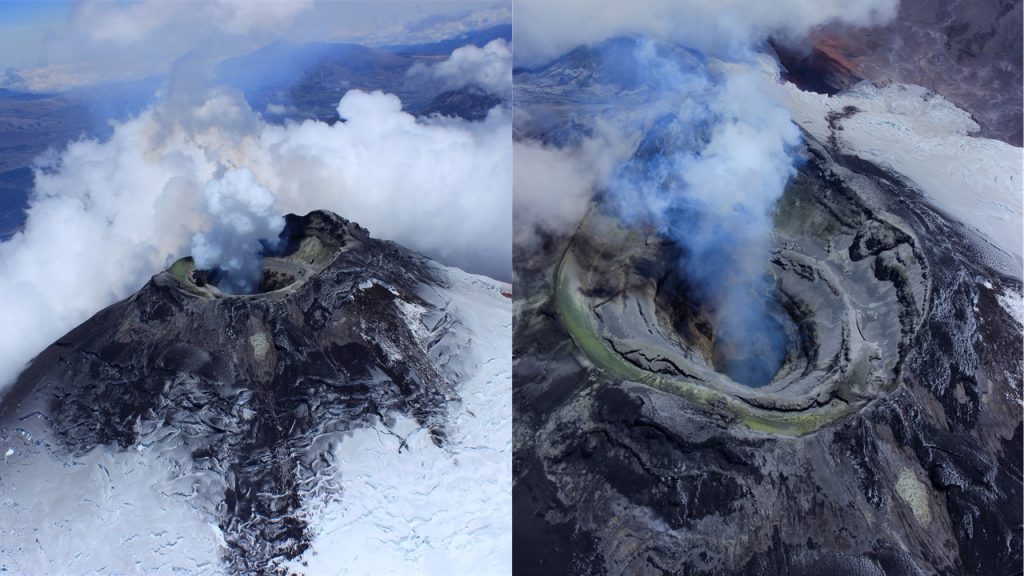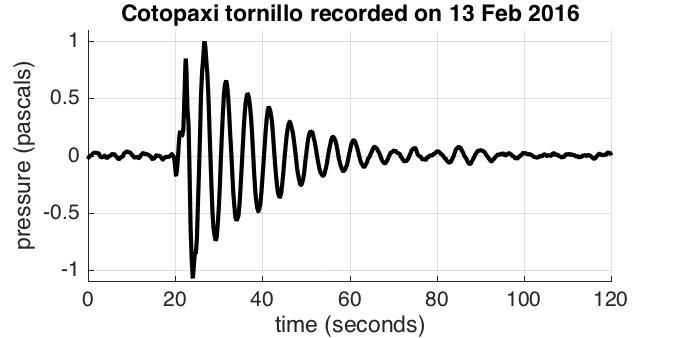13 June 2018
WASHINGTON — A volcano in Ecuador with a deep cylindrical crater might be the largest musical instrument on Earth, producing unique sounds scientists could use to monitor its activity.
New infrasound recordings of Cotopaxi volcano in central Ecuador show that after a sequence of eruptions in 2015, the volcano’s crater changed shape. The deep narrow crater forced air to reverberate against the crater walls when the volcano rumbled. This created sound waves like those made by a pipe organ, where pressurized air is forced through metal pipes.
“It’s the largest organ pipe you’ve ever come across,” said Jeff Johnson, a volcanologist at Boise State University in Idaho and lead author of a new study detailing the findings in Geophysical Research Letters, a journal of the American Geophysical Union.
The new findings show the geometry of a volcano’s crater has a major impact on the sounds a volcano can produce. Understanding each volcano’s unique “voiceprint” can help scientists better monitor these natural hazards and alert scientists to changes going on inside the volcano that could signal an impending eruption, according to the study authors.
“Understanding how each volcano speaks is vital to understanding what’s going on,” Johnson said. “Once you realize how a volcano sounds, if there are changes to that sound, that leads us to think there are changes going on in the crater, and that causes us to pay attention.”

Instituto Geofisico researchers maintain a monitoring station at Cotopaxi volcano in central Ecuador. A new study shows Cotopaxi produces unique sounds scientists could use to monitor the volcano and its hazards.
Credit: Silvia Vallejo Vargas/Insituto Geofisico, Escuela Politecnica Nacional (Quito, Ecuador).
The ongoing eruption of Kilauea in Hawaii could be a proving ground for studying how changes to a crater’s shape influence the sounds it makes, according to Johnson. The lava lake at Kilauea’s summit drained as the magma supplying it flowed downward, which should change the tones of the infrasounds emitted by the crater.
Listening to Kilauea’s infrasound could help scientists monitor the magma depth from afar and forecast its potential eruptive hazards, according to David Fee, a volcanologist at the University of Alaska Fairbanks who was not connected to the new study. When magma levels at Kilauea’s summit drop, the magma can heat groundwater and cause explosive eruptions, which is believed to have happened at Kilauea over the past several weeks. This can change the infrasound emitted by the volcano.
“It’s really important for scientists to know how deep crater is, if the magma level is at the same depth and if it’s interacting with the water table, which can create a significant hazard,” Fee said.
Detecting a new kind of sound
Cotopaxi was dormant for most of the 20th century, but it erupted several times in August of 2015. The eruptions spewed ash and gas into the air, endangering the more than 300,000 people who live near the volcano. A massive eruption could melt Cotopaxi’s immense snowcap, which would trigger massive floods and mudflows that could reach nearby cities and towns.

Views of the top of Cotopaxi’s long, cylindrical crater. After a sequence of eruptions in 2015, the crater floor dropped out of sight.
Credit: Silvia Vallejo Vargas/Insituto Geofisico, Escuela Politecnica Nacional (Quito, Ecuador).
The 2015 eruptions were relatively minor but triggered an explosion that caused the crater floor to drop out of sight. That was when Ecuadorian researchers monitoring the volcano noticed weird sounds coming from the crater. The frequency of the sound waves was too low for humans to hear, but they were recorded by the scientists’ instruments. The researchers dubbed the sounds tornillos, the Spanish word for screws, because the sound waves looked like screw threads. They oscillated back and forth for about 90 seconds, getting smaller each time, before fading into the background.
Johnson likens it to the “old Western bar door” that once opened, swings back and forth several times before coming to rest. But because of the crater’s size – it’s more than 100 meters (300 feet) wide and about 300 meters (1,000 feet) deep – it takes five seconds for the sound waves to go through one full oscillation.
“It’s like opening a bar door that goes back and forth for a minute and a half,” Johnson said. “It’s a beautiful signal and amazing that the natural world is able to produce this type of oscillation.”

Scientists dubbed Cotopaxi’s sounds ‘tornillos’ because the sound waves looked like screw threads.
Credit: Jeff Johnson.
Pipe organ players create sounds with similar characteristics by using a keyboard to force air through pipes of differing lengths. This is the first time volcanologists have recorded sounds of such low frequency and with this dramatic reverberation coming from a volcano, according to Johnson.
The crater produced tornillo sounds about once a day for the first half of 2016, before they stopped. Johnson and his colleagues are unsure exactly what caused the sounds, but they know it had something to do with the volcano’s activity and not just wind blowing across the top of the crater. Each tornillo was associated with gas coming out of the vent, Johnson said.
The researchers suspect one of two things could have excited the volcano into producing the tornillos. Part of the crater floor could have been collapsing, as can happen when magma moves under a volcano, or an explosion was taking place at the bottom of the crater. Explosions are common in open-vent craters like Cotopaxi, where gas accumulates until it reaches a pressure high enough to explode.
###
The American Geophysical Union is dedicated to advancing the Earth and space sciences for the benefit of humanity through its scholarly publications, conferences, and outreach programs. AGU is a not-for-profit, professional, scientific organization representing 60,000 members in 137 countries. Join the conversation on Facebook, Twitter, YouTube, and our other social media channels.
Notes for Journalists
This paper is freely available for 30 days. Journalists and public information officers (PIOs) can download a PDF copy of the article by clicking on this link: https://agupubs.onlinelibrary.wiley.com/doi/pdf/10.1029/2018GL077766.
Multimedia (images, audio, video) accompanying this press release can be downloaded here:
https://www.dropbox.com/sh/bt1bhuw442qbc4x/AAA9CzbgjJAusXxbOEc1pIzma?dl=0
Journalists and PIOs may also order a copy of the final paper by emailing a request to Lauren Lipuma at [email protected]. Please provide your name, the name of your publication, and your phone number.
Neither the paper nor this press release is under embargo.
“Infrasound Tornillos Produced by Volcán Cotopaxi’s Deep Crater”
Authors:
Jeffrey B. Johnson: Department of Geosciences, Boise State University, Boise, Idaho, U.S.A.;
Mario Calixto Ruiz, Guillermo Viracucha, Patricio Ramon, Marco Almeida: Escuela Politecnica Nacional, Quito, Ecuador;
Hugo D. Ortiz: Pontifica Universidad Católica del Ecuador, Quito, Ecuador;
Leighton M. Watson: Department of Geophysics, Stanford University, Stanford, California, U.S.A.
Contact information for the authors:
Jeffrey B. Johnson: [email protected], +1 (208) 971-5832
Lauren Lipuma
+1 (202) 777-7396
[email protected]